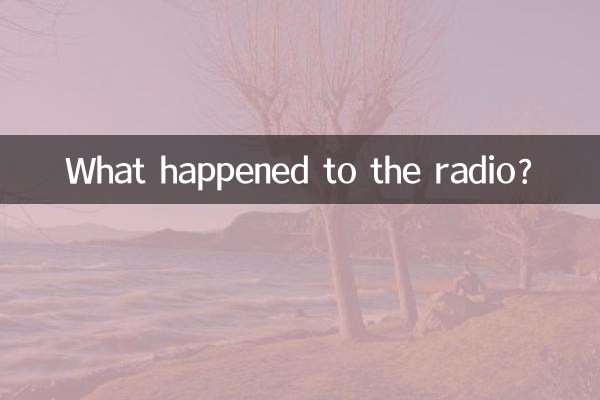What happened to the radio?
In today's era of information explosion, radio seems to have become a symbol of nostalgia, but the principles and history behind it are still worth exploring. This article will combine recent hot topics to provide a structured analysis of the working principle, development history and modern applications of radios.
1. Recent hot topics and content (last 10 days)

| Ranking | topic | heat index | Related fields |
|---|---|---|---|
| 1 | AI voice assistant upgrade | 9.2 | Technology |
| 2 | Retro electronics collection craze | 8.7 | culture |
| 3 | Increased demand for emergency communications equipment | 7.5 | society |
| 4 | radio drama revival phenomenon | 6.9 | entertainment |
2. Working principle of radio
A radio is a device that receives radio waves and converts them into sound signals. Its core process can be divided into the following steps:
| steps | Function module | Technical points |
|---|---|---|
| 1 | antenna reception | Capturing electromagnetic waves in space |
| 2 | Tuned circuit | Select a specific frequency signal |
| 3 | demodulator | Separating the audio signal from the carrier wave |
| 4 | amplifier | Increase electrical signal strength |
| 5 | Speaker | electrical signals converted into sound waves |
3. A brief history of the development of radio
From Marconi's radio experiments to modern digital broadcasting, radio has gone through five key stages of development:
| period | Technical characteristics | Typical products |
|---|---|---|
| 1890-1920 | spark gap transmitter | ore radio |
| 1920-1950 | tube technology | Philips Superheterodyne |
| 1950-1970 | transistor revolution | Sony TR-63 |
| 1970-2000 | integrated circuit | Tecsun PL-600 |
| 2000 to present | digital broadcast | internet radio |
4. Modern application scenarios
Based on recent hot topics, it can be seen that radio technology is still reborn in many fields:
1.emergency communications: During natural disasters, traditional radios remain a reliable source of information. During the 2024 earthquake in Japan, radio usage surged by 300%.
2.sound economy: The resurgence of podcasts and radio dramas has boosted the sales of smart radio devices. Ximalaya’s smart radio shipments will reach 1.2 million units in 2023.
3.educational tools: Solar radios are used for remote teaching in remote areas of Africa, covering more than 2 million students.
4.nostalgic economy: The price of retro radios on second-hand trading platforms has increased by 45% year-on-year, becoming the new favorite of Generation Z.
5. Comparison of technical parameters
| Type | frequency range | Power consumption | price range |
|---|---|---|---|
| Traditional AM/FM | 535-1605kHz/88-108MHz | 3-5W | 50-300 yuan |
| DigitalDAB+ | 174-240MHz | 8-10W | 500-1500 yuan |
| internet radio | Wi-Fi/4G | 15-20W | 800-3000 yuan |
Conclusion
Looking back at the nature of technology from current hot spots, radio is not only a milestone in the history of human communications, but also a technological carrier of continuous evolution. In the AIoT era, radio technology is integrating with new technologies such as speech recognition and edge computing. Its core logic of "receiving-decoding-playing" still affects the architectural design of modern audio equipment. Understanding the principles of radio not only satisfies nostalgia, but is also an important foundation for grasping the future development trend of smart audio.

check the details

check the details